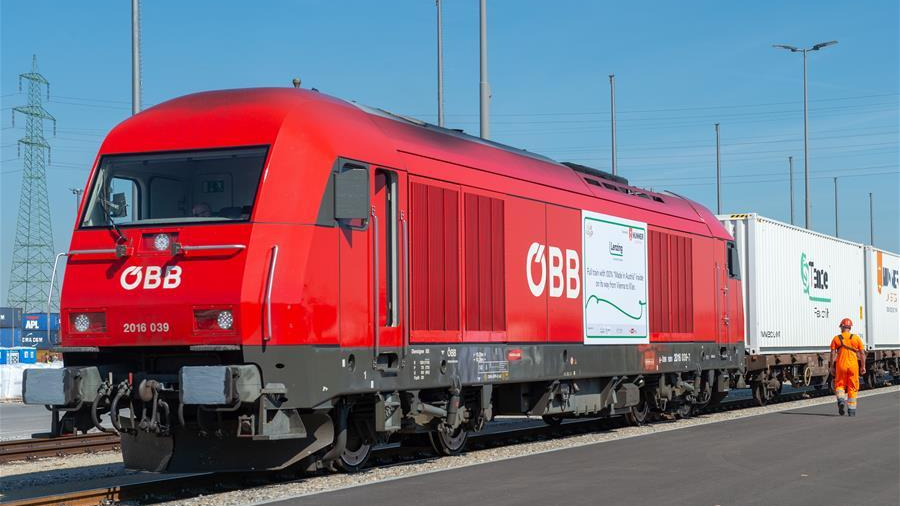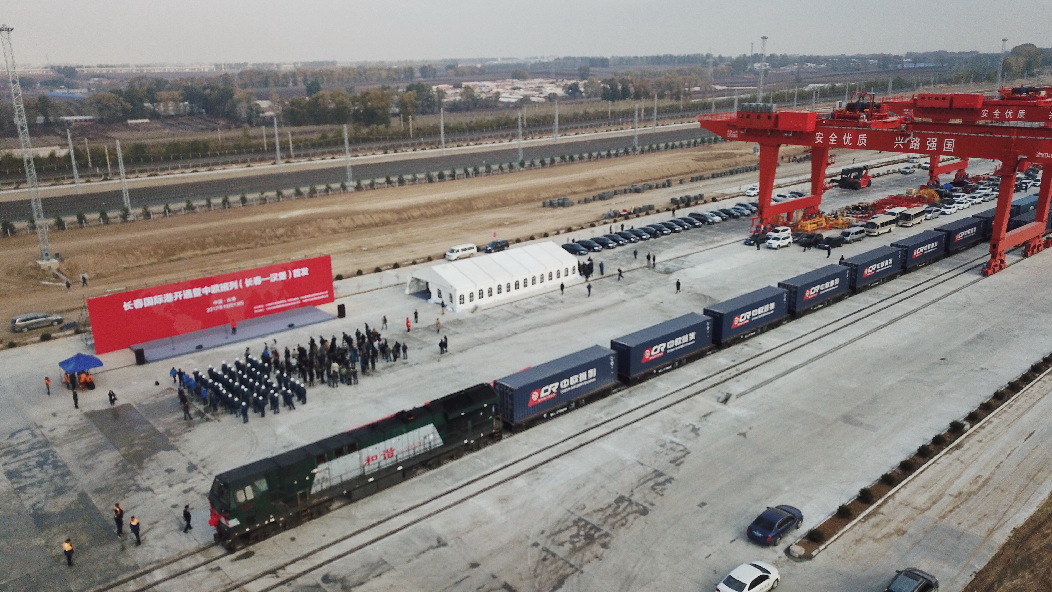
A freight train with "Made in Austria" goods prepares to leave the Vienna South Terminal for China, August 20, 2020. /Xinhua
A freight train with "Made in Austria" goods prepares to leave the Vienna South Terminal for China, August 20, 2020. /Xinhua
Editor's note: Djoomart Otorbaev is former Prime Minister of the Kyrgyz Republic, a distinguished professor of the Belt and Road School under Beijing Normal University, and a member of Nizami Ganjavi International Center. The article reflects the author's views, and not necessarily those of CGTN.
In the first part of this article, I described the current status and exponential growth of the rail freight traffic between China and Europe through the territory of modern Eurasia. With such impressive development and dynamism, it would be important to investigate its future perspectives, to understand where its current bottlenecks are, and what may potentially hinder further growth of the traffic.
Most experts agree that there are two key medium-term challenges. First, on how to balance the number of trains from China to Europe and those from Europe to China. The second one is the issue of insufficient capacity of crossing points at the Belarus-Polish border.
These days roughly two-thirds of railway shipments are westbound, with only one-third are going in the opposite direction. The situation is unlikely to change in the short term. The most positive development would be the rise in China's domestic consumption, which could generate more demand for European imports.
With a simple glance at the map of railway transportation between China and Europe, it is easy to see that almost all trains move through the Brest (Belarus) - Małaszewicze (Poland) crossing point. This is mainly because Russia for political reasons is unwilling to allow transit trains to pass to Europe through Ukraine. It is looking likely that this situation will last for quite some time.
Due to the difference between track gauges used by Russia, Kazakhstan, Belarus and Mongolia (1,520 mm) on the one hand and by European countries and China (1,435 mm) on the other, the connection of railway routes between China and Europe require cargo transshipments, bogie exchange, or automated gauge conversion technology.
It is often claimed that differences in track gauge are a major barrier to increasing freight traffic. But in my opinion, this barrier is not critical. There are greater capacity challenges within the EU railway network. Most of Europe's rail system is much older than China's and has fundamental capacity constraints.
The biggest bottleneck remains logistics limitations around the Małaszewicze border area. Currently, the modernization project that will significantly increase the handling capacity of that area is on the way. The costs, which will be financed from both Polish and EU budgets, are estimated at around 700 million euros.
When the work is completed, the Małaszewicze neighborhood will be completely modernized. The project includes major improvements in rail infrastructure of the area, such as higher speed of freight trains and higher axle load.

The first freight train of China Railway Express from Changchun to Hamburg in northeast China's Jilin Province, October 13, 2017. /Xinhua
The first freight train of China Railway Express from Changchun to Hamburg in northeast China's Jilin Province, October 13, 2017. /Xinhua
Differences in container train lengths impose another limitation and higher costs. While in Russia an average train has 71 ordinary railway cars, and in Belarus 57–65 railway cars, in EU 43 cars. Accordingly, trains leaving Małaszewicze can have a maximum of 43 cars carrying 86 TEU. As a result, if a 71-car container train arrives at the border with Poland, the cars have to split up: a 43-car train is composed as the containers are transhipped in Brest, while the remaining 28 cars have to wait at the station for the next train.
From cost and speed to the "soft" factors such as unified customs standards, minimization and simplification of administrative procedures, and other solutions settled under multilateral agreements, are all of great importance.
In my opinion, the main reasons for the explosive growth of railway traffic along the China-Europe route are the following.
Firstly, the strengthened competitiveness of the Chinese economy, and associated with it the explosive export growth to the European markets; secondly, the rising export from China of high-value goods that require faster delivery in comparison with classic sea transportation; thirdly, the Chinese government's "go west" policy, which prioritizes the development of its central and western landlocked provinces, and from where the rail transportation to Europe will be cheaper and faster; fourthly, due to the growing prosperity of the population, an increasing number of Chinese people want to consume high-quality and expensive European goods; and fifthly, the creation of the Eurasian customs union allow goods to travel freely and give the forwarders a virtually non-stop, fast and cost-efficient train services.
Most experts believe that sustainable growth of container traffic within the next couple of years is secured. Lower freight rates will be required to secure the growth. It should be supported by investments in physical infrastructure, transport and logistics centers, locomotives, border crossing infrastructure, digitalization of procedures through blockchains and smart contracts, by the unification of regulatory frameworks, and better coordination of freight rate policies among partners.
There is every reason to believe that the Eurasian railway revolution will continue in the nearest future. All fundamental factors are in place for the continuation and development of this "New Silk Road." Increasing the capacity of existing routes and laying new railways, such as the building of new and shorter "southern" route from China through the territories of Kyrgyzstan, Uzbekistan, Turkmenistan, Iran and Turkey to Europe, will undoubtedly strengthen and consolidate current successes.
(If you want to contribute and have specific expertise, please contact us at opinions@cgtn.com.)